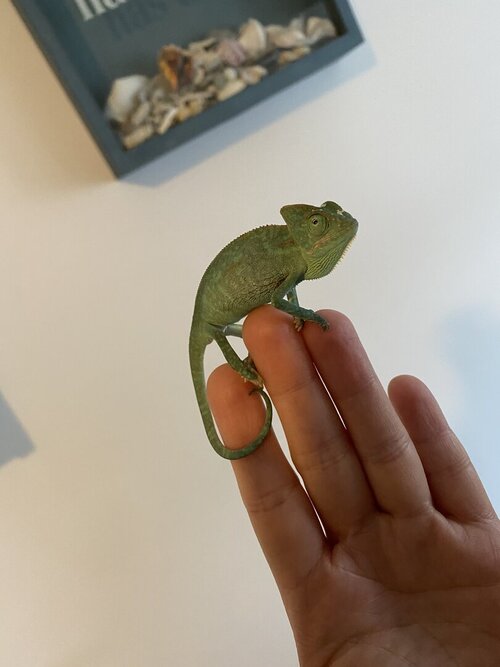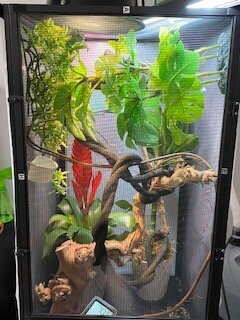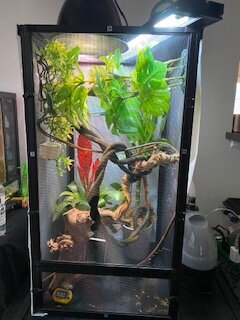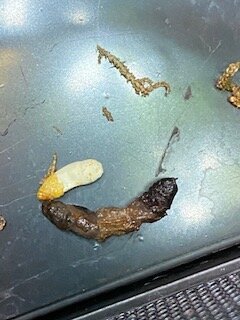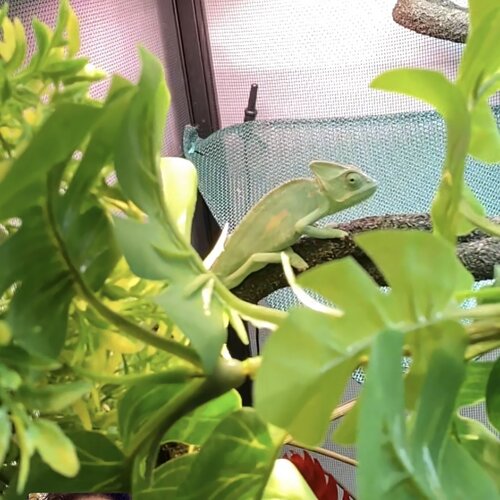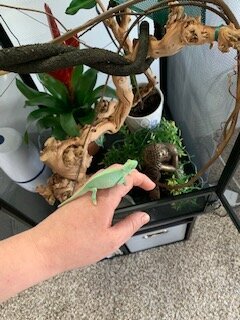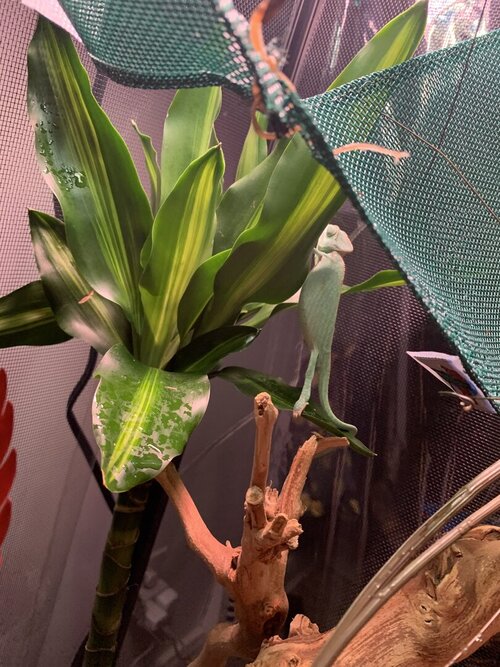Meet Diego
My gf and I decided to go the pet store with a 8 week old Cham.
Stupid? yes. Irrational? absolutely. Ignorant? no denial here.
But it was no mistake, as we always take full responsibility for our actions and when we bring in a new baby will do 150% what we can to do what we need to do to give them the life they deserve. We have been looking up and learning and giving this our best for the last two weeks. We have dogs and a snake and have had a frog in the past, but had no idea what Chams need and what to expect. Our $50 little green lizard is officially a $5000 (exaggerating slightly after food and cages and supplies and you name it) juvenile male veiled chameleon.
SO HERE IS THE KICKER!!! WE HAVE TWO HOUSES and TRAVEL BETWEEN THEM ALL THE TIME! So we do need to teach him to be able to travel well to the best of our ability and learn to live in two places. We travel about 2 hours up to 4 times a week due to our living and work arrangements. (Yes we did buy a chameleon without researching and had no idea they are so easily stressed and are so fond of their enclosures and not changing environments) So here we are trying to figure out the best route of going about all this! He travels in a specific cage to keep him safe and currently has one cage that gets moved between the two houses. Eventually due to the size of the cage he will need, he will have two separate (but the "same") ones set up at each house. More info below in the enclosure section.
I come to you all with this story is to get some advice and tips and constructive judgement on our enclosure, our care, and most definitely on how to make little dudes traveling as easy and least stressful as possible.
Chameleon Info:
My gf and I decided to go the pet store with a 8 week old Cham.
Stupid? yes. Irrational? absolutely. Ignorant? no denial here.
But it was no mistake, as we always take full responsibility for our actions and when we bring in a new baby will do 150% what we can to do what we need to do to give them the life they deserve. We have been looking up and learning and giving this our best for the last two weeks. We have dogs and a snake and have had a frog in the past, but had no idea what Chams need and what to expect. Our $50 little green lizard is officially a $5000 (exaggerating slightly after food and cages and supplies and you name it) juvenile male veiled chameleon.
SO HERE IS THE KICKER!!! WE HAVE TWO HOUSES and TRAVEL BETWEEN THEM ALL THE TIME! So we do need to teach him to be able to travel well to the best of our ability and learn to live in two places. We travel about 2 hours up to 4 times a week due to our living and work arrangements. (Yes we did buy a chameleon without researching and had no idea they are so easily stressed and are so fond of their enclosures and not changing environments) So here we are trying to figure out the best route of going about all this! He travels in a specific cage to keep him safe and currently has one cage that gets moved between the two houses. Eventually due to the size of the cage he will need, he will have two separate (but the "same") ones set up at each house. More info below in the enclosure section.
I come to you all with this story is to get some advice and tips and constructive judgement on our enclosure, our care, and most definitely on how to make little dudes traveling as easy and least stressful as possible.
Chameleon Info:
- Male Veiled Cham 10 weeks old.
- How long has it been in your care? **2 weeks-
- Handling
- How often do you handle your chameleon?- At first, daily as we were trying to improve his enclosure. But now we are letting him destress so not until he is ready..
- Feeding-
- Crickets (daily but are going to cut back), dubia roaches, super worms (daily offered but rarely eaten), horn worms (1 or 2 a week), wax worms and meal worms (i know they aren't good, we got them to supplement until the store ships our new bugs out. BSF larvae is on the way in addition.
- he is given about 15-18 bugs daily but not until the last two days did he finally start eating well today was 14 so far
- How are you gut-loading your feeders?
- feeders are housed with fresh veggies (and the unnecessary orange flucker and yellow calcified water crystals)
- Supplements-
- What brand and type of calcium and vitamin products are you dusting your feeders with and what is the schedule?
- 6 days a week calcium without D3, the 7th day is Calcium with D3 or multivit (alternated)
- What brand and type of calcium and vitamin products are you dusting your feeders with and what is the schedule?
- Watering-
- What kind of watering technique do you use?
- so he is humidified at night and that leaves water on the plants, during the day he has a dripper.
- How often and how long to you mist?
- we started misting twice daily but were seeing too much humification flux so now just once 30-60 mins before lights on.
- Do you see your chameleon drinking?
- not really, maybe a couple times, but we have seen him on the leaf that the water falls on.
- What kind of watering technique do you use?
- Fecal Description-
- Briefly note colors and consistency from recent droppings.
- we got dehydrated due to humidity issues and stress and then urates became bright orange. we finally are making progress and I posted todays: some yellow urate mostly white and a larger formed poo
- Has this chameleon ever been tested for parasites?
- i have not done a float or got it tested.
- Briefly note colors and consistency from recent droppings.
- Cage Type-
- currently-- he has a 18x18x36 reptiscreen and that size fits in our car for travel, but Diego rides in a safer enclosure during the car ride. But we do take this same enclosure for both locations. We assumed keeping the same enclosure in both houses keeps as much consistency as we can for him for time being. Each location has the exact same stand also so that he is at the same height and stability for familiarity.
- future cage-- We do have two cages that are the 24x24x48 reptiscreens. We haven't set him up in them because we cannot fit them in the car so he will have two separate cages at both of the houses. we have duplicates of everything for both cages and plan on trying to duplicate the setup for him as best we can.
- travel cage-- currently he is in a reptile critter tank during transport. Its a glass tank we wrapped with tropical aquarium wallpaper (only has a small peek hole so we can look in to check on him, has the reptile screen top, a towel in the bottom, a hammock he can hold on to and a small artificial vine for hiding. we can also have a small dual light set up for top to provide heat and UVB while on the road.
- Lighting-
- What brand, model, and types of lighting are you using?
- 40 watt daytime heating light in a 10 in dome
- reptisun UVB HO T5 bar light 5.0
- LED small round light for the plants
- What is your daily lighting schedule?
- 0800-2000 on a timer
- What brand, model, and types of lighting are you using?
- Temperature-
- What temp range have you created (cage floor to basking spot)?
- 72 or so at the bottom and 85-90 at the absolute highest branch. We know 85* is more ideal but we are only at a 40 bulb and he does have alternate basking spots.
- Lowest overnight temp?
- Lowest we've seen is 68*F-72*F
- How do you measure these temps?
- digital temp near the top and then another digital temp/hydrometer at the bottom
- What temp range have you created (cage floor to basking spot)?
- Humidity-
- What are your humidity levels?
- Daytime 55-70%
- Nighttime 70-90%
- How are you creating and maintaining these levels?
- one mist before lights on, humidifier overnight, plants and moss at bottom, and dripper on during the day
- What do you use to measure humidity?
- hydrometer-digital
- What are your humidity levels?
- Plants-
- live bromiliad, live dracaena
- artificial plants (one plastic and one silk) which are going to be replaced soon. we haven't yet due to trying to let him destress
- SOON: live mostera deliciosa and live pothos (to replace the fakes)
- Placement-
- Where is your cage located? Is it near any fans, air vents, or high traffic areas?
- house 1: spare bedroom (low traffic)
- House 2: living room (medium traffic, family only but rarely a lot a guest)
- At what height is the top of the cage relative to your room floor?
- its elevated on a table so maybe 32 inches from floor
- Where is your cage located? Is it near any fans, air vents, or high traffic areas?
- Location-
- Ohio
Attachments
Last edited:

